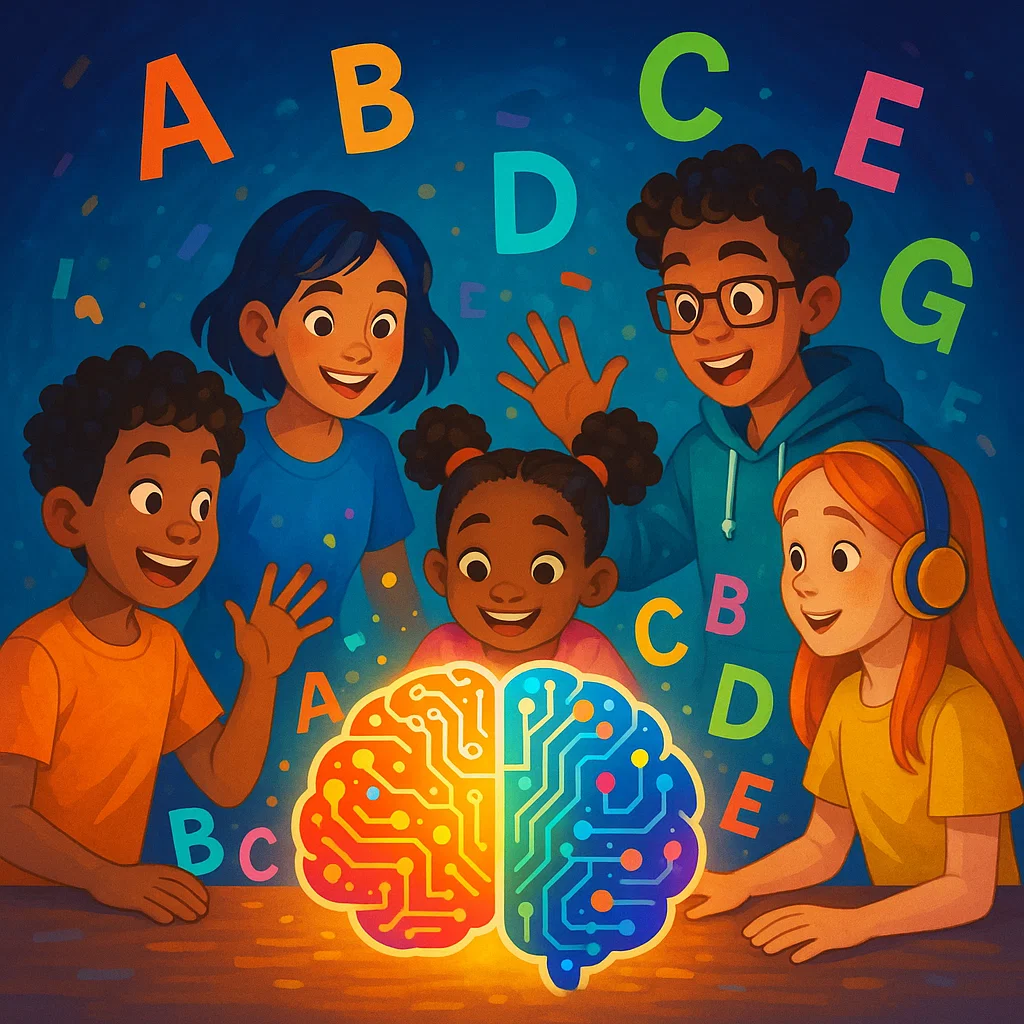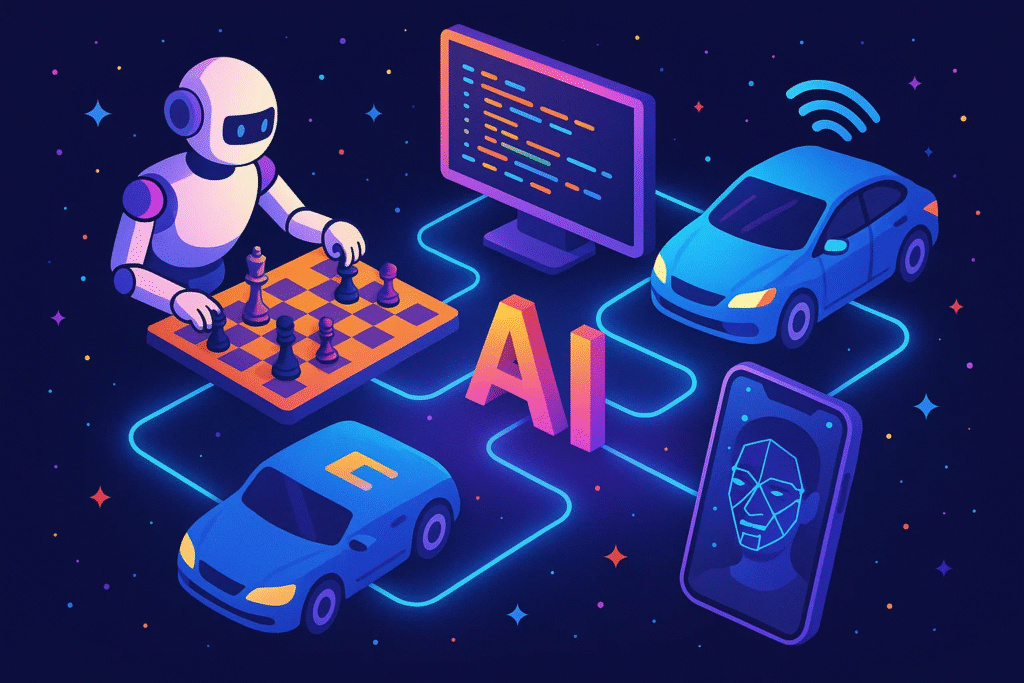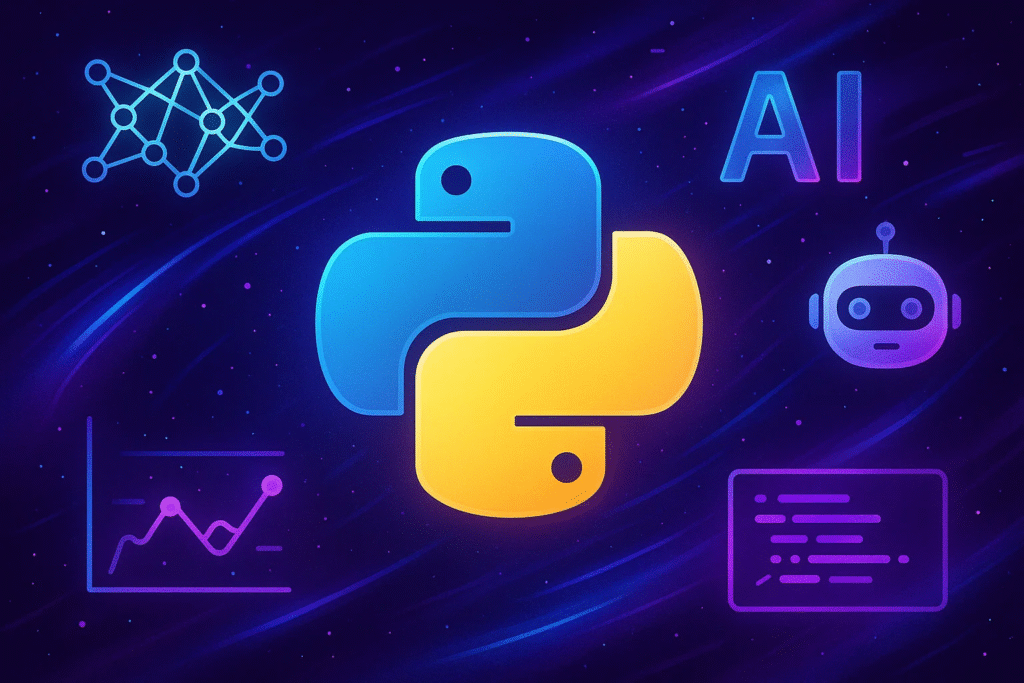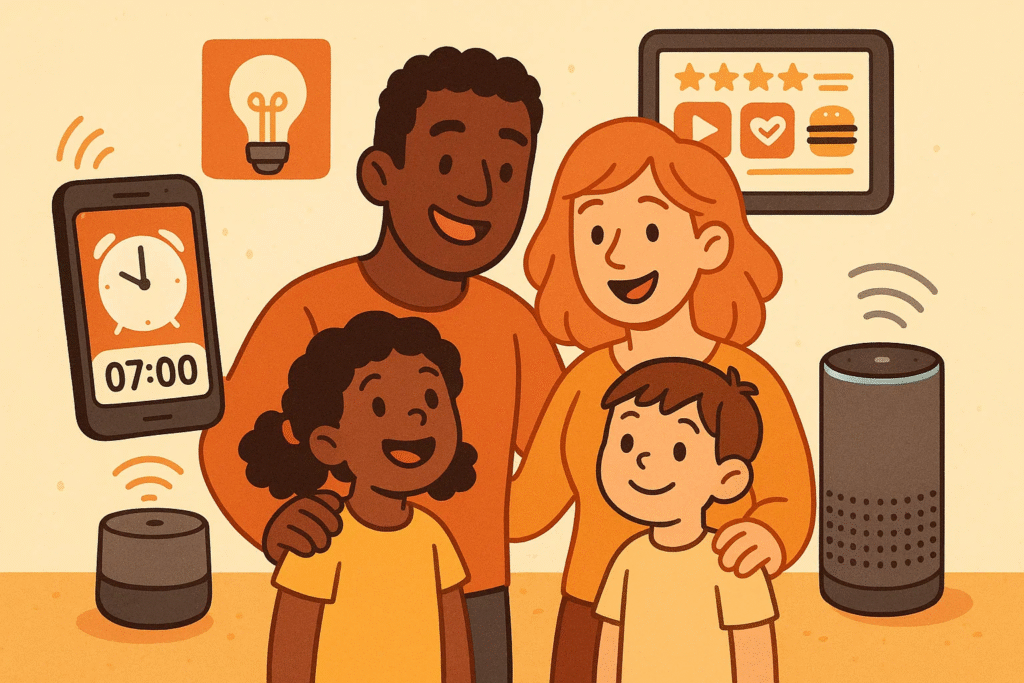
Reading Time: 13 mins

Feeling overwhelmed by artificial intelligence terminology and wondering where to start your AI learning journey? You’re not alone. With AI revolutionizing everything from smartphones to self-driving cars, millions of students, parents, and educators are struggling to understand these complex concepts without getting lost in technical jargon.
The consequences of staying behind in AI literacy are significant. As AI becomes increasingly integrated into our daily lives and future careers, those without basic AI knowledge risk being left out of the technological revolution that’s reshaping our world.
That’s where this comprehensive ABCs of AI guide comes in. I’ve spent years teaching technology concepts to young learners, and I’ve discovered that breaking down artificial intelligence into digestible, alphabetical segments makes even the most complex topics accessible and exciting. This guide will transform you from an AI beginner into someone who confidently understands artificial intelligence fundamentals, complete with real-world examples and practical applications.

Artificial Intelligence, commonly known as AI, is like giving computers and machines the ability to think, learn, and make decisions similar to how humans do. Think of it as teaching a computer to be smart enough to recognize your voice, recommend your favorite videos, or even help doctors diagnose diseases.
In my experience teaching technology to young learners, I’ve found that AI is best understood as a collection of technologies that enable machines to perform tasks that typically require human intelligence. These tasks include understanding language, recognizing images, making predictions, and solving complex problems.
The field of artificial intelligence encompasses several key areas including machine learning, natural language processing, computer vision, and robotics. Each of these areas contributes to making AI systems more capable and useful in our daily lives.
Let’s explore artificial intelligence through an alphabetical journey that covers essential concepts, technologies, and applications. This approach makes learning AI fundamentals both systematic and memorable.
Algorithm is the foundation of all AI systems. Think of an algorithm as a recipe that tells a computer exactly what steps to follow to solve a problem. Just like following a recipe to bake cookies, computers follow algorithms to make decisions and learn from data.
Artificial Intelligence itself represents the umbrella term for all technologies that enable machines to simulate human intelligence. From the smart recommendations on your streaming platform to voice assistants understanding your questions, AI is everywhere.
Big Data refers to enormous amounts of information that AI systems use to learn and improve. Imagine trying to read every book in the world – that’s similar to how AI processes massive datasets to discover patterns and make predictions.
Bots are AI-powered programs designed to automate tasks. From chatbots that answer customer questions to social media bots that moderate content, these digital assistants are becoming increasingly sophisticated.
Computer Vision enables machines to “see” and understand images and videos. This technology powers everything from facial recognition in photos to self-driving cars that can identify stop signs and pedestrians.
Coding remains the fundamental skill for anyone interested in AI development. Programming languages like Python are particularly popular for AI projects due to their simplicity and powerful libraries.
Deep Learning represents a subset of machine learning inspired by how human brains work. Using artificial neural networks with multiple layers, deep learning systems can recognize complex patterns in data, enabling breakthroughs in image recognition and natural language processing.
Data Science combines statistics, programming, and domain expertise to extract insights from data. Data scientists are like digital detectives, using AI tools to uncover hidden patterns and trends in information.
AI Ethics addresses crucial questions about fairness, privacy, and responsibility in artificial intelligence. As AI becomes more powerful, ensuring these systems are developed and used ethically becomes increasingly important.
Expert Systems are AI programs designed to solve problems in specific domains by mimicking human expertise. These systems use rules and knowledge bases to make decisions in fields like medical diagnosis or financial planning.
Fuzzy Logic allows AI systems to handle uncertainty and partial truths, much like human reasoning. Instead of simple yes/no decisions, fuzzy logic enables more nuanced decision-making.
Facial Recognition technology uses computer vision to identify individuals based on their facial features. While powerful, this technology raises important privacy and security considerations.
GPT (Generative Pre-trained Transformer) represents a breakthrough in natural language processing, enabling AI systems to generate human-like text, answer questions, and even write code.
Gaming AI has driven many AI innovations, from chess-playing computers to modern game characters that adapt to player behavior. Games provide excellent environments for testing and developing AI algorithms.

Human-Computer Interaction (HCI) focuses on making AI systems more intuitive and user-friendly. Good HCI design ensures that powerful AI capabilities remain accessible to users of all technical backgrounds.
Heuristics are problem-solving approaches that use practical methods to find solutions quickly, even if they’re not perfect. AI systems often use heuristics to make decisions when perfect solutions would take too long to compute.
Internet of Things (IoT) connects everyday devices to the internet, enabling them to collect and share data. When combined with AI, IoT devices become smarter and more responsive to user needs.
Image Recognition allows computers to identify and classify objects, people, and scenes in digital images. This technology powers everything from photo tagging to medical imaging analysis.
JavaScript has become increasingly important in AI development, especially for web-based AI applications and interactive coding projects. Modern JavaScript frameworks enable developers to build sophisticated AI-powered web applications.
AI Jobs represent one of the fastest-growing career categories. From AI engineers to data scientists, the demand for AI-skilled professionals continues to expand across industries.
Knowledge Representation involves structuring information so that AI systems can use it effectively. This includes creating databases, ontologies, and other formats that help machines understand and reason about information.
K-Means is a popular clustering algorithm used in unsupervised learning to group similar data points together. It’s commonly used in market segmentation and image processing.
Large Language Models (LLMs) like GPT represent AI systems trained on vast amounts of text data to understand and generate human language. These models have revolutionized natural language processing applications.
Logic in AI involves using formal reasoning methods to make decisions and solve problems. Logical reasoning helps AI systems draw conclusions from given information, similar to how humans use deductive reasoning.
Machine Learning enables computers to learn and improve from experience without being explicitly programmed for every task. It’s like teaching a computer to recognize patterns and make predictions based on examples.
Neural Networks are AI architectures inspired by how biological brains work. These networks consist of interconnected nodes that process information and learn to recognize complex patterns.
Natural Language Processing (NLP) enables computers to understand, interpret, and generate human language. From language translation to sentiment analysis, NLP makes human-computer communication more natural.
Artificial Neurons are the basic building blocks of neural networks. These mathematical functions receive inputs, process them, and produce outputs, mimicking how biological neurons work in the brain.
Optimization involves finding the best solution among many possible options. AI systems use optimization techniques to improve their performance and efficiency over time.
Object Detection combines classification and localization to identify and locate objects within images or videos. This technology is essential for applications like autonomous vehicles and security systems.
Python Programming has become the go-to language for AI development due to its simplicity and extensive libraries like TensorFlow and PyTorch. Many AI tutorials and projects start with Python basics.
Prediction represents one of AI’s most valuable capabilities – using historical data and patterns to forecast future events or outcomes. Predictive AI helps in everything from weather forecasting to stock market analysis.

Quantum Computing promises to revolutionize AI by solving certain types of problems exponentially faster than traditional computers. While still emerging, quantum AI could transform fields like drug discovery and optimization.
Quality Assurance in AI involves testing and validating AI systems to ensure they perform reliably and safely. This includes checking for bias, accuracy, and robustness across different scenarios.
Robotics combines AI with physical machines to create systems that can interact with the real world. From manufacturing robots to personal assistants, robotics represents AI in action.
Reinforcement Learning teaches AI systems through trial and error, similar to how humans learn new skills. The system receives rewards for good decisions and penalties for poor ones, gradually improving its performance.
Supervised Learning uses labeled examples to teach AI systems to make predictions or classifications. It’s like having a teacher show examples of correct answers before asking students to solve similar problems.
Speech Recognition converts spoken language into text, enabling voice-controlled systems and accessibility features. This technology has made AI more accessible to users who prefer voice interaction.
Training Data represents the information used to teach AI systems. The quality and quantity of training data significantly impact how well an AI system performs its intended tasks.
Transfer Learning allows AI models trained on one task to be adapted for related tasks, similar to how learning to ride a bicycle helps with learning to ride a motorcycle.
Unsupervised Learning finds hidden patterns in data without labeled examples. It’s like asking someone to find similarities among a group of objects without telling them what to look for.
User Experience (UX) in AI focuses on making AI systems intuitive and helpful for users. Good AI UX design ensures that powerful capabilities remain accessible and understandable.
Virtual Assistants like Siri, Alexa, and Google Assistant combine multiple AI technologies to provide voice-activated help with various tasks. These systems demonstrate how different AI components work together.
Validation ensures that AI models perform well on new, unseen data. Proper validation prevents overfitting and helps build more reliable AI systems.
Weak AI (or Narrow AI) refers to AI systems designed for specific tasks, unlike the general intelligence humans possess. Most current AI applications fall into this category.
Web Development increasingly incorporates AI features, from chatbots to recommendation systems. Understanding both web technologies like HTML and CSS and AI concepts becomes valuable for modern developers.
Explainable AI (XAI) focuses on making AI decisions transparent and understandable to humans. As AI systems become more complex, explaining their reasoning becomes crucial for trust and adoption.
XML and other data formats play important roles in AI systems for storing and exchanging structured information between different components.
YOLO (You Only Look Once) is a popular real-time object detection algorithm that can identify multiple objects in images quickly and accurately.
Yield in AI contexts often refers to the output or results produced by AI systems, as well as optimization techniques that maximize desired outcomes.
Zero-Shot Learning enables AI systems to recognize or perform tasks they weren’t explicitly trained on, demonstrating a form of generalization similar to human learning.
AI Zones represent different areas or domains where AI is applied, from healthcare and education to entertainment and transportation.
Understanding the ABCs of AI becomes more meaningful when we see how these concepts apply to our daily experiences. In my years of teaching technology to young learners, I’ve observed that students grasp AI concepts better when they can connect them to familiar activities.
Consider your morning routine: your smartphone’s alarm uses AI to learn your sleep patterns, your email filters spam using machine learning algorithms, and your music app recommends songs based on artificial intelligence analysis of your preferences. These applications demonstrate how multiple AI concepts work together seamlessly.
Educational games for kids increasingly incorporate AI to adapt difficulty levels and provide personalized learning experiences. This personalization represents the practical application of algorithms, data analysis, and user experience design working in harmony.
Smart home devices showcase computer vision (recognizing faces), natural language processing (understanding voice commands), and IoT integration (connecting multiple devices). These systems exemplify how the ABCs of AI combine to create intelligent, responsive environments.

Beginning your AI journey doesn’t require advanced mathematics or computer science degrees. Based on my experience helping students navigate technology education, I recommend starting with fundamental concepts before diving into complex implementations.
Foundation Building: Start with basic programming concepts using beginner-friendly languages. Python programming offers an excellent entry point due to its readable syntax and extensive AI libraries. Understanding variables in Python provides the foundation for more advanced AI programming concepts.
Visual Learning Approaches: Block coding platforms like Scratch introduce programming logic without syntax complexity. These platforms help students understand algorithmic thinking, which forms the basis of all AI programming.
Hands-On Projects: Creating simple projects reinforces learning. Start with basic games in Scratch or simple Python calculators to build confidence before tackling AI-specific challenges.
Structured Learning Paths: Consider enrolling in coding programs designed for kids that provide structured curricula and mentorship. These programs often include AI concepts as part of comprehensive technology education.
Transitioning from understanding AI concepts to implementing them requires practical programming skills. My experience teaching young programmers has shown that success comes from building projects that combine creativity with technical learning.
Essential Programming Concepts: Before diving into AI-specific libraries, master fundamental programming concepts including loops, conditionals, functions, and data structures. These building blocks appear in all AI programming, regardless of the specific application.
Popular AI Programming Languages: While Python remains the dominant AI language, JavaScript has gained popularity for web-based AI applications. Understanding both languages expands your AI development possibilities.
Beginner-Friendly AI Projects: Start with simple projects like:
Learning Resources: Utilize online platforms that combine theory with practice. Many successful AI students benefit from interactive coding adventures that make learning engaging and memorable.
Image Placement 6: After “AI Programming” section Image Prompt: “Screen capture style illustration showing code editor with colorful Python AI code, alongside cute robot character pointing at the screen, programming workspace with multiple monitors, encouraging learning atmosphere”
The artificial intelligence landscape continues evolving rapidly, with new developments reshaping how we interact with technology. Understanding emerging trends helps prepare for future opportunities and challenges in AI.
Emerging AI Technologies: Quantum computing promises to accelerate AI computations exponentially. While still in early stages, quantum AI could solve optimization problems that are currently impossible for classical computers.
AI in Education: The impact of AI on kids’ education continues growing, with personalized learning systems adapting to individual student needs. STEM education increasingly incorporates AI concepts to prepare students for future careers.
Ethical Considerations: As AI becomes more powerful, addressing ethical concerns becomes crucial. Future AI development must balance innovation with responsibility, ensuring these technologies benefit society while minimizing potential harms.
Career Opportunities: The demand for AI-skilled professionals continues expanding across industries. Unexpected careers involving coding now include fields like digital art, music production, and environmental science.
Integration with Other Technologies: AI increasingly combines with robotics, IoT, and augmented reality to create more sophisticated and useful systems. Understanding these intersections opens new possibilities for innovation and application.
Q: What age is appropriate to start learning about AI? A: Children can begin understanding basic AI concepts as early as elementary school through age-appropriate activities and educational games. The key is presenting concepts through hands-on activities and relatable examples rather than complex theory.
Q: Do I need advanced math skills to understand AI? A: While advanced mathematics helps with deep AI research, beginners can understand and work with AI concepts using basic math skills. Focus on building programming skills and conceptual understanding first, then advance to mathematical concepts as needed.
Q: What’s the difference between AI and machine learning? A: Artificial Intelligence is the broader field focused on creating intelligent machines, while machine learning is a subset of AI that enables systems to learn from data without explicit programming for every task.
Q: Can kids really build AI projects? A: Absolutely! Using platforms like Scratch for coding and age-appropriate AI tools, children can create simple AI projects that demonstrate core concepts while building confidence and interest in technology.
Q: What career opportunities exist in AI? A: AI careers span numerous fields including software development, data science, robotics engineering, AI ethics, and specialized roles in industries like healthcare, finance, and entertainment. Many STEM careers now incorporate AI components.
Q: How can parents support their children’s AI learning? A: Parents can support their child’s coding journey by encouraging curiosity, providing access to age-appropriate learning resources, and celebrating creative projects that incorporate technology concepts.
Mastering the ABCs of AI represents just the beginning of an exciting technological adventure. Based on my experience guiding students through technology education, sustained learning requires combining theoretical understanding with practical application.
Immediate Actions:
Long-term Development: Consider structured learning through coding programs that provide mentorship and peer interaction. These programs often accelerate learning while building valuable networking connections.
Explore robotics and coding opportunities that combine AI concepts with physical computing. This hands-on approach reinforces abstract concepts through tangible results.
Staying Current: AI technology evolves rapidly, making continuous learning essential. Follow reputable AI education resources, participate in coding challenges, and experiment with new tools and platforms as they become available.
The artificial intelligence revolution is reshaping our world, and understanding these fundamental concepts positions you to participate in this transformation. Whether you’re a student, parent, or educator, the ABCs of AI provide the foundation for navigating our increasingly intelligent technological landscape.
Ready to dive deeper into AI and coding education? Explore our comprehensive coding and robotics programs designed to make technology learning accessible, engaging, and inspiring for learners of all ages.
Image Placement 7: At the end before CTA Image Prompt: “Inspirational illustration showing diverse young people holding graduation caps made of circuit boards, standing in front of a bright technological cityscape with AI symbols floating in the sky, hopeful and empowering mood, graduation/achievement theme”
Last Updated: January 2025 | Author: AI Education Specialist with 15+ years experience in technology education and curriculum development